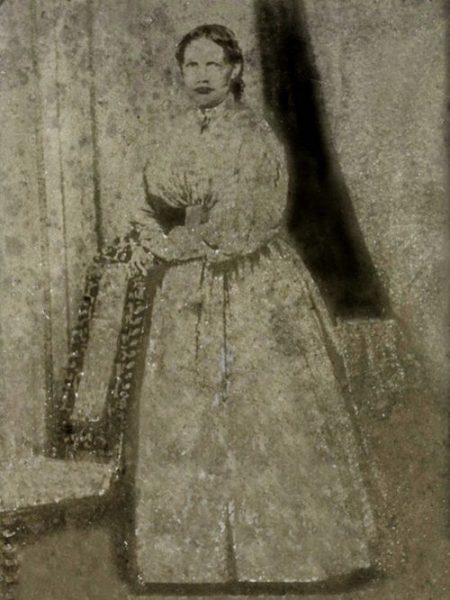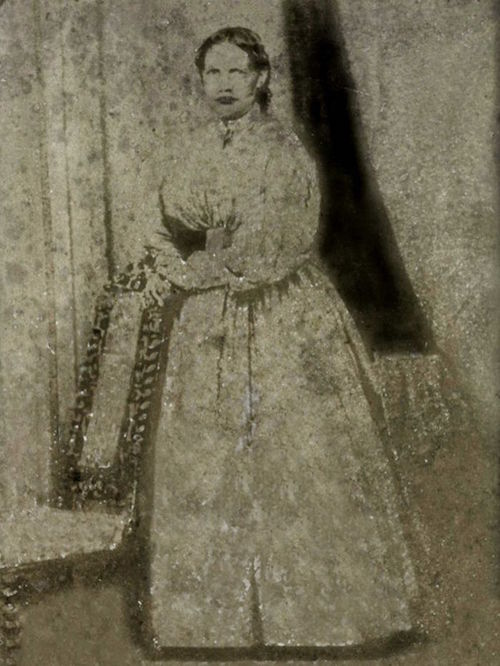Written by Elizabeth Heffernan, RAHS Volunteer
To celebrate Women’s History Month in 2020, the Royal Australian Historical Society will continue our work from last year to highlight Australian women that have contributed to our history in various and meaningful ways. You can browse the women featured on our webpage, Women’s History Month.
Aboriginal and Torres Strait Islander people are advised that this webpage contains the images and names of people who have passed away.
Proud Worimi woman, mother of an estimated fifteen children, and one of the country’s first female bushrangers, Mary Ann Bugg more than deserves her own place in history. Since her rise to fame in the 1860s for her role in the legend of Captain Thunderbolt, famously the last of New South Wales’ bushrangers, Mary Ann has been both obscured and sensationalised within the historic record. Until recently, it was rare to find a version of her story where Thunderbolt was not the focus. [1]

Mary Ann Bugg: outlaw, mother, modern woman.
No longer. Modern historians have since uncovered a far richer tapestry of Mary Ann’s life that spans beyond the five years she spent as Thunderbolt’s “chief lieutenant and right-hand man”. [2] It is a story of perseverance, ingenuity, and survival during a time when society and the justice system were far from kind towards Aboriginal Australians and outlaw bushrangers – let alone a woman who was both.
Mary Ann was born near Gloucester on the mid-north coast of NSW in 1834. Her parents, a convict worker and Worimi woman respectively, were unusual in their long-term, consensual relationship and eventual marriage. Their decision to send Mary Ann and her younger brother to Sydney for education was even stranger for the time. In the city, Mary Ann learned literacy skills that alienated her from her peers back home, but which would prove invaluable during her bushranging career. [3]
Mary Ann married Edmund Baker at the age of fourteen. She possibly had a child with him before their separation in 1849-50. In the years before she met Thunderbolt in 1860, known then as Frederick Ward, there is evidence Mary Ann bore as many as five more children. [4] Yet this period of Mary Ann’s life remains in shadow. It was only after Ward’s infamous escape from Cockatoo Island in 1863 that Mary Ann stepped into the light.
Some histories suggest Mary Ann had a hand in her partner’s prison break, though the evidence is fleeting. What is known is that, from 1863 to 1867, Frederick Ward and Mary Ann Bugg – Captain Thunderbolt and “the captain’s lady” – led an outlaw existence that culminated in Ward being shot to death in Uralla in 1870. [5]
Though most contemporary media sources from the time focus on Thunderbolt’s solo exploits, Mary Ann made some noticeable appearances. In 1865, while on the hunt for Ward, police encountered a pregnant Mary Ann instead. The Maitland Mercury reported how she “sprung up like a tigress upon one of the police … taunting him”. [6] Upon her arrest Mary Ann faked labour contractions and when left at the station by her arresting officers, escaped with Ward. The following year she was arrested for vagrancy; in court, Senior Sergeant Kerrigan listed one of her major crimes as dressing in men’s pants. [7]
In 1867, after Mary Ann’s third and final arrest for stealing twelve yards of fabric, she wrote her own petition to Governor Sir John Young explaining her unlawful imprisonment. Her statement caused public support to stream in and forced the inspector-general to find her “wrongfully convicted”. [8] That same year she and Thunderbolt separated. When a woman associated with Ward matching Mary Ann’s description was found dead from pneumonia, the public believed her gone for good. Many historians believed the same.
Only recently has it come to light that the woman found dead was very likely Louisa Mason, an Aboriginal woman who rode with Ward but not Mary Ann Bugg. Mary Ann, in fact, is now believed to have survived long after the infamous death of Captain Thunderbolt. Sources suggest she died in Mudgee in 1905, the mother of at least five more children. [9] Loyal to Thunderbolt and an ingenious bushranger in her own right, it is Mary Ann’s survival past her outlaw years that is the true testament of her courage as a partner, mother, and Aboriginal Australian woman making her own way in the world.
References:
[1] David Andrew Roberts and Carol Baxter, ‘“Mrs Thunderbolt”: Setting the record straight on the life and times of Mary Ann Bugg’, Journal of the Royal Australian Historical Society 99, no. 1 (June 2013): 70.
[2] Maitland Mercury, 15 May 1866, 3, in Roberts and Baxter, ‘“Mrs Thunderbolt”’, 55.

